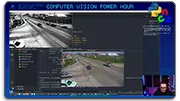How to Start with JavaScript: A Beginner’s Guide
Learn the basics of JavaScript and how to get started with this powerful programming language. Our comprehensive guide covers everything from setting up your development environment to writing your first JavaScript code. Start your journey today!
Updated: October 19, 2023

This YouTube channel is packed with awesome videos for coders!
Tons of videos teaching JavaScript and coding. Cool live streams!
Click Here to check out the Channel!JavaScript is a powerful programming language that is widely used for web development. If you are new to JavaScript, starting can be overwhelming. In this article, we will provide a step-by-step guide on how to start with JavaScript and some code demonstrations to help you get started.
Step 1: Set up your environment
Before you start learning JavaScript, you need to set up your environment. Here are the basic steps you need to follow:
Install Node.js
Node.js is a JavaScript runtime that allows you to run JavaScript on the server-side. You can download Node.js from the official website: https://nodejs.org/en/. Follow the installation instructions for your operating system.
Install a code editor
A code editor is a software application that allows you to write, edit, and debug code. Some popular code editors for JavaScript development are Sublime Text, Atom, and Visual Studio Code. Choose one that suits your needs and install it on your computer.
Create a new project
Once you have installed Node.js and a code editor, create a new project. You can create a new folder in your computer and name it (e.g., “my-javascript-project”). Open your code editor and create a new file inside the project folder. Give the file a .js extension (e.g., “main.js”).
Step 2: Learn the basics of JavaScript
Now that you have set up your environment, it’s time to start learning JavaScript. Here are some basic concepts and code demonstrations to get you started:
Variables and Data Types
Variables are used to store data in JavaScript. You can declare a variable using the var keyword followed by the name of the variable and its data type (e.g., var myName = "John";). Here is an example code snippet that declares two variables:
var myName = "John";
var myAge = 25;
Conditional Statements
Conditional statements allow you to execute a block of code based on a certain condition. You can use the if keyword followed by a condition and a block of code that will be executed if the condition is true (e.g., if (myAge > 18) { console.log("You are eligible to vote."); }). Here is an example code snippet that uses an if statement:
var myAge = 25;
if (myAge > 18) {
console.log("You are eligible to vote.");
}
Loops
Loops allow you to execute a block of code repeatedly until a certain condition is met. You can use the for keyword followed by a condition and a block of code that will be executed repeatedly (e.g., for (var i = 0; i < 5; i++) { console.log(i); }). Here is an example code snippet that uses a for loop:
for (var i = 0; i < 5; i++) {
console.log(i);
}
Step 3: Practice and Build Projects
Now that you have learned the basics of JavaScript, it’s time to practice and build projects. Here are some tips to help you improve your skills:
Practice Coding Challenges
Coding challenges are a great way to improve your coding skills. You can find coding challenges online or join online communities that provide coding challenges (e.g., HackerRank, CodeWars).
Build Small Projects
Start building small projects to apply what you have learned. You can start with simple projects like a calculator, a weather app, or a game. As you progress, you can move on to more complex projects.
Join Online Communities
Join online communities of JavaScript developers to learn from others and get feedback on your projects. Some popular online communities are Reddit’s r/javascript, Stack Overflow, and freeCodeCamp.
Conclusion
Starting with JavaScript can seem overwhelming at first, but with the right resources and a step-by-step guide, you can quickly get started. In this article, we provided a step-by-step guide on how to start with JavaScript and some code demonstrations to help you get started. Remember to practice coding challenges, build small projects, and join online communities to improve your skills. Happy coding!
